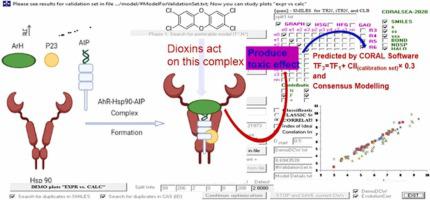Environmental Toxicology and Pharmacology ( IF 4.2 ) Pub Date : 2022-05-30 , DOI: 10.1016/j.etap.2022.103893 Parvin Kumar 1 , Ashwani Kumar 2 , Devender Singh 3

|
In the present study, ninety-five halogenated dioxins and related chemicals (dibenzo-p-dioxins, dibenzofurans, biphenyls, and naphthalene) with endpoint pEC50 were used to develop twelve quantitative structure toxicity relationship (QSTR) models using inbuilt Monte Carlo algorithm of CORAL software. The hybrid optimal descriptor of correlation weights (DCW) using a combination of SMILES and HSG (hydrogen suppressed graph) was employed to generate QSTR models. Three target functions i.e. TF1 (WIIC=WCII=0), TF2 (WIIC= 0.3 & WCII=0) and TF3 (WIIC= 0.0 &WCII=0.3) were employed to develop robust QSTR models and the statistical outcomes of each target function were compared with each other. The correlation intensity index (CII) was found a reliable benchmark of the predictive potential for QSTR models. The numerical value of the determination coefficient of the validation set of split 1 computed by TF3 was found highest (). The fragments responsible for the toxicity of dioxins and related chemicals were also identified in terms of the promoter of increase/decrease for pEC50. Three random splits (Split 1, Split 2 and Split 4) were selected for the extraction of the promoter of increase/decrease for pEC50. In the last, consensus modelling was performed using the intelligent consensus tool of DTC lab (https://dtclab.webs.com/software-tools). The original consensus model, which was created by combining four distinct models employing the split 4 arrangement, was more predictive for the validation set and the numerical value of the determination coefficient of the test set (validation set) was increased from 0.8133 to 0.9725. For the validation set of split 4, the mean absolute error (MAE 100%) was also lowered from 0.513 to 0.2739.
中文翻译:

CORAL:开发基于混合描述符的 QSTR 模型,通过相关强度指数和共识模型预测二恶英和二恶英类化合物的毒性
在本研究中,使用端点 pEC 50的95 种卤代二恶英和相关化学品(二苯并-对二恶英、二苯并呋喃、联苯和萘),使用内置的 Monte Carlo 算法开发了 12 个定量结构毒性关系 (QSTR) 模型珊瑚软件。使用结合 SMILES 和 HSG(氢抑制图)的相关权重混合最优描述符 (DCW) 用于生成 QSTR 模型。三个目标函数即 TF 1 (W IIC =W CII =0)、TF 2 (W IIC = 0.3 & W CII =0) 和 TF 3 (W IIC = 0.0 &W CII= 0.3) 用于开发稳健的 QSTR 模型,并将每个目标函数的统计结果相互比较。相关强度指数 (CII) 被发现是 QSTR 模型预测潜力的可靠基准。TF 3计算出的 split 1 的验证集的决定系数数值最高()。还根据 pEC 50增加/减少的促进剂确定了导致二恶英和相关化学品毒性的片段。选择三个随机拆分(拆分 1、拆分 2 和拆分 4)用于提取 pEC 50增加/减少的启动子. 最后,使用 DTC 实验室的智能共识工具(https://dtclab.webs.com/software-tools)进行共识建模。最初的共识模型是通过结合使用 split 4 排列的四个不同模型创建的,对验证集的预测性更强,测试集(验证集)的确定系数的数值从 0.8133 增加到 0.9725。对于拆分 4 的验证集,平均绝对误差 (MAE 100%) 也从 0.513 降低到 0.2739。









































 京公网安备 11010802027423号
京公网安备 11010802027423号